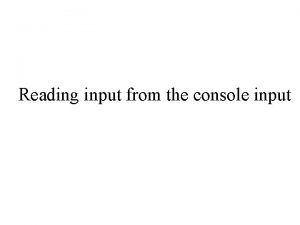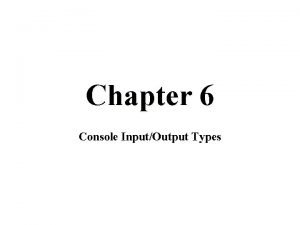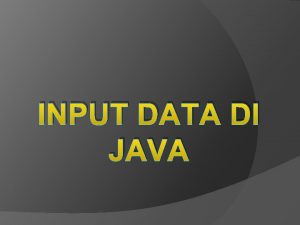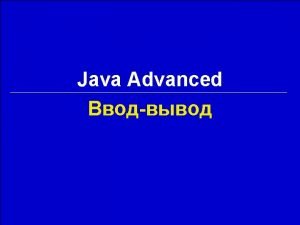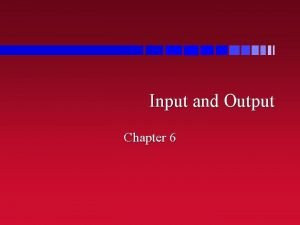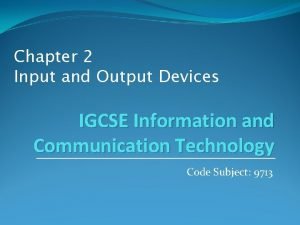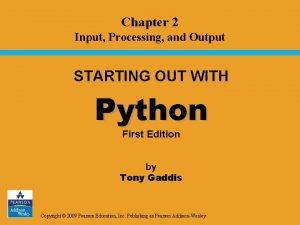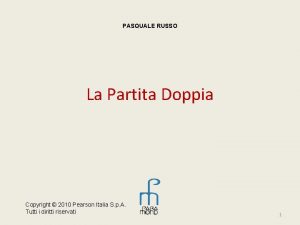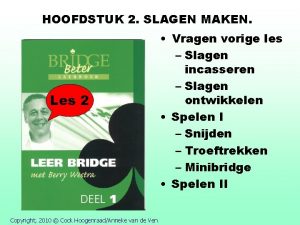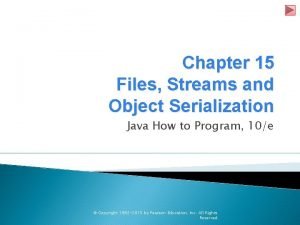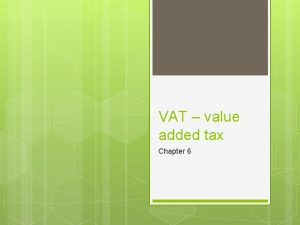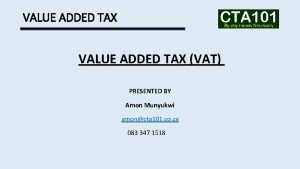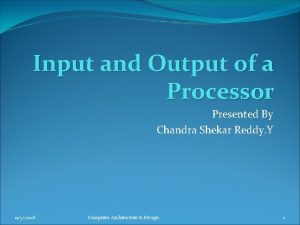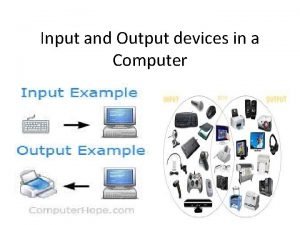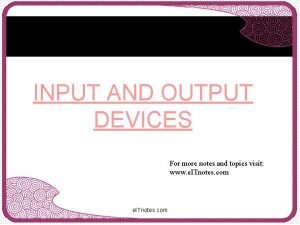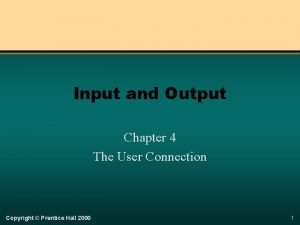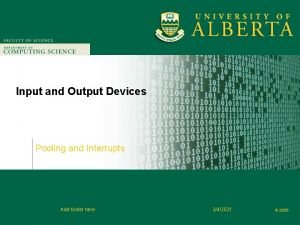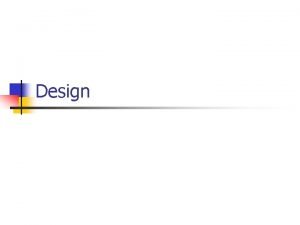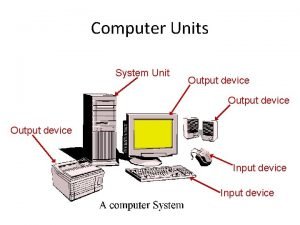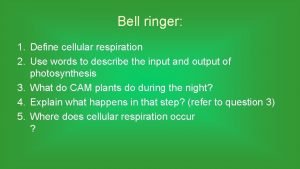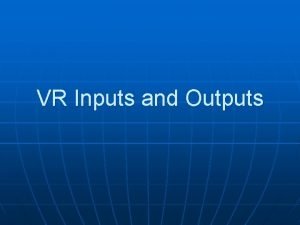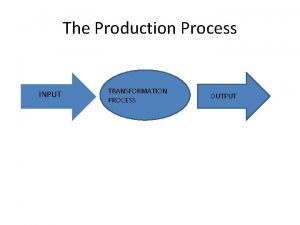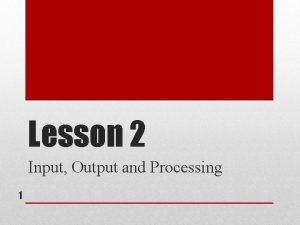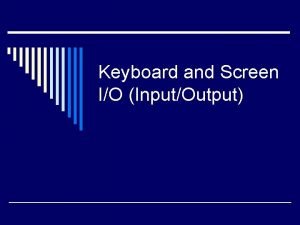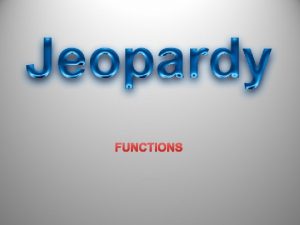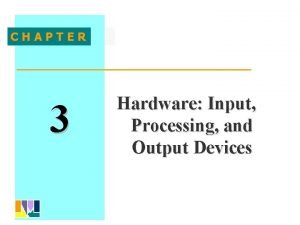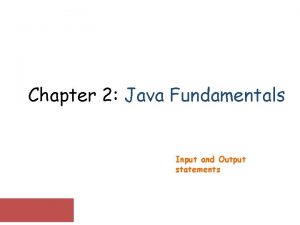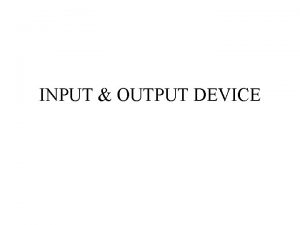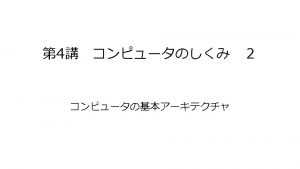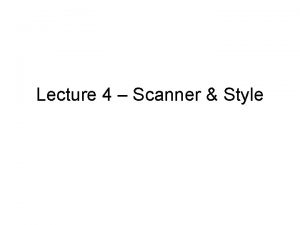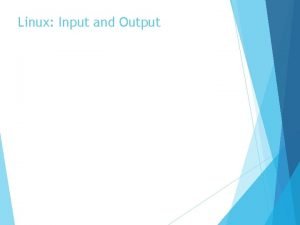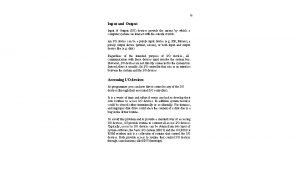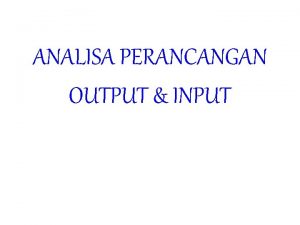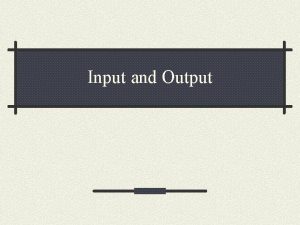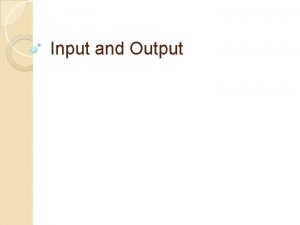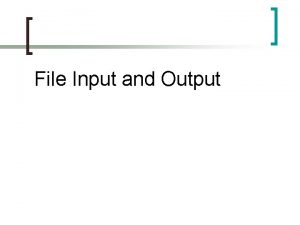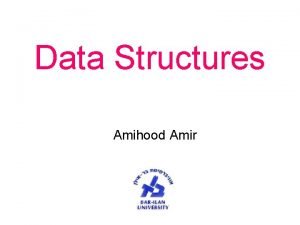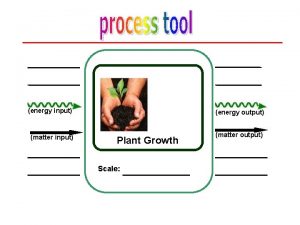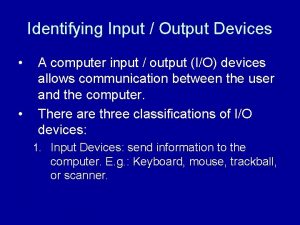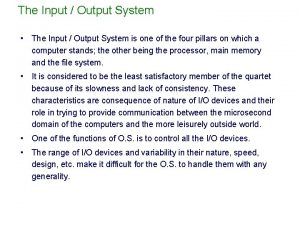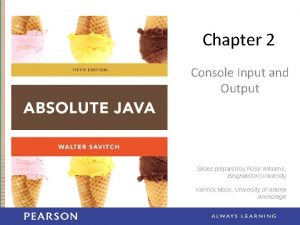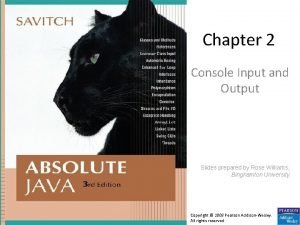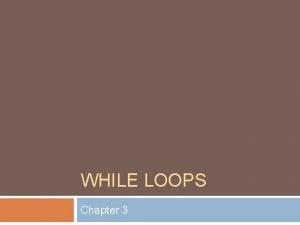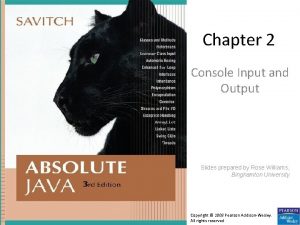Chapter 2 Console Input and Output Copyright 2010


















































- Slides: 50

Chapter 2 Console Input and Output Copyright © 2010 Pearson Addison-Wesley. All rights reserved.

System. out. println for console output • System. out is an object that is part of the Java language • println is a method invoked by the System. out object that can be used for console output – The data to be output is given as an argument in parentheses – A plus sign is used to connect more than one item – Every invocation of println ends a line of output System. out. println("The answer is " + 42); Copyright © 2010 Pearson Addison-Wesley. All rights reserved. 2 -2

println Versus print • Another method that can be invoked by the System. out object is print • The print method is like println, except that it does not end a line – With println, the next output goes on a new line – With print, the next output goes on the same line Copyright © 2010 Pearson Addison-Wesley. All rights reserved. 2 -3

Formatting Output with printf • Starting with version 5. 0, Java includes a method named printf that can be used to produce output in a specific format • The Java method printf is similar to the print method – Like print, printf does not advance the output to the next line • System. out. printf can have any number of arguments – The first argument is always a format string that contains one or more format specifiers for the remaining arguments – All the arguments except the first are values to be output to the screen Copyright © 2010 Pearson Addison-Wesley. All rights reserved. 2 -4

printf Format Specifier • The code double price = 19. 8; System. out. print("$"); System. out. printf("%6. 2 f", price); System. out. println(" each"); will output the line $ 19. 80 each • The format string "%6. 2 f" indicates the following: – End any text to be output and start the format specifier (%) – Display up to 6 right-justified characters, pad fewer than six characters on the left with blank spaces (i. e. , field width is 6) – Display exactly 2 digits after the decimal point (. 2) – Display a floating point number, and end the format specifier (i. e. , the conversion character is f) Copyright © 2010 Pearson Addison-Wesley. All rights reserved. 2 -5

Right and Left Justification in printf • The code double value = 12. 123; System. out. printf("Start%8. 2 f. End", value); System. out. println(); System. out. printf("Start%-8. 2 f. End", value); System. out. println(); will output the following Start 12. 12 End Start 12. 12 End • The format string "Start%8. 2 f. End" produces output that is right justified with three blank spaces before the 12. 12 • The format string "Start%-8. 2 f. End" produces output that is left justified with three blank spaces after the 12. 12 Copyright © 2010 Pearson Addison-Wesley. All rights reserved. 2 -6

Multiple arguments with printf • The following code contains a printf statement having three arguments – The code double price = 19. 8; String name = "magic apple"; System. out. printf("$%6. 2 f for each %s. ", price, name); System. out. println("Wow"); will output $ 19. 80 for each magic apple. Wow – Note that the first argument is a format string containing two format specifiers (%6. 2 f and %s) – These format specifiers match up with the two arguments that follow (price and name) Copyright © 2010 Pearson Addison-Wesley. All rights reserved. 2 -7

Line Breaks with printf • Line breaks can be included in a format string using %n • The code double price = 19. 8; String name = "magic apple"; System. outprintf("$%6. 2 f for each %s. %n", price, name); System. out. println("Wow"); will output $ 19. 80 for each magic apple. Wow Copyright © 2010 Pearson Addison-Wesley. All rights reserved. 2 -8

Format Specifiers for System. out. printf Copyright © 2010 Pearson Addison-Wesley. All rights reserved. 2 -9

The printf Method (Part 1 of 3) Copyright © 2010 Pearson Addison-Wesley. All rights reserved. 2 -10

The printf Method (Part 2 of 3) Copyright © 2010 Pearson Addison-Wesley. All rights reserved. 2 -11

The printf Method (Part 3 of 3) Copyright © 2010 Pearson Addison-Wesley. All rights reserved. 2 -12

Formatting Money Amounts with printf • A good format specifier for outputting an amount of money stored as a double type is %. 2 f • It says to include exactly two digits after the decimal point and to use the smallest field width that the value will fit into: double price = 19. 99; System. out. printf("The price is $%. 2 f each. ") produces the output: The price is $19. 99 each. Copyright © 2010 Pearson Addison-Wesley. All rights reserved. 2 -13

Legacy Code • Code that is "old fashioned" but too expensive to replace is called legacy code • Sometimes legacy code is translated into a more modern language • The Java method printf is just like a C language function of the same name • This was done intentionally to make it easier to translate C code into Java Copyright © 2010 Pearson Addison-Wesley. All rights reserved. 2 -14

Money Formats • Using the Number. Format class enables a program to output amounts of money using the appropriate format – The Number. Format class must first be imported in order to use it import java. text. Number. Format – An object of Number. Format must then be created using the get. Currency. Instance() method – The format method takes a floating-point number as an argument and returns a String value representation of the number in the local currency Copyright © 2010 Pearson Addison-Wesley. All rights reserved. 2 -15

Money Formats import java. text. Number. Format; public class Currency. Format. Demo { public static void main(String[] args) { System. out. println("Default location: "); Number. Format money. Formater = Number. Format. get. Currency. Instance(); System. out. println(money. Formater. format(19. 8)); System. out. println(money. Formater. format(19. 81111)); System. out. println(money. Formater. format(19. 89999)); System. out. println(money. Formater. format(19)); System. out. println(); } } Copyright © 2010 Pearson Addison-Wesley. All rights reserved. 2 -16

Money Formats • Output of the previous program Default location: $19. 80 $19. 81 $19. 90 $19. 00 Copyright © 2010 Pearson Addison-Wesley. All rights reserved. 2 -17

Specifying Locale • Invoking the get. Currency. Instance() method without any arguments produces an object that will format numbers according to the default location • In contrast, the location can be explicitly specified by providing a location from the Locale class as an argument to the get. Currency. Instance() method – When doing so, the Locale class must first be imported import java. util. Locale; Copyright © 2010 Pearson Addison-Wesley. All rights reserved. 2 -18

Specifiying Locale import java. text. Number. Format; import java. util. Locale; public class Currency. Format. Demo { public static void main(String[] args) { System. out. println("US as location: "); Number. Format money. Formater 2 = Number. Format. get. Currency. Instance(Locale. US); System. out. println(money. Formater 2. format(19. 8)); System. out. println(money. Formater 2. format(19. 81111)); System. out. println(money. Formater 2. format(19. 89999)); System. out. println(money. Formater 2. format(19)); } } Copyright © 2010 Pearson Addison-Wesley. All rights reserved. 2 -19

Specifying Locale • Output of the previous program US as location: $19. 80 $19. 81 $19. 90 $19. 00 Copyright © 2010 Pearson Addison-Wesley. All rights reserved. 2 -20

Locale Constants for Currencies of Different Countries Copyright © 2010 Pearson Addison-Wesley. All rights reserved. 2 -21

Importing Packages and Classes • Libraries in Java are called packages – A package is a collection of classes that is stored in a manner that makes it easily accessible to any program – In order to use a class that belongs to a package, the class must be brought into a program using an import statement – Classes found in the package java. lang are imported automatically into every Java program import java. text. Number. Format; // import the. Number. Format class only import java. text. *; //import all the classes in package java. text Copyright © 2010 Pearson Addison-Wesley. All rights reserved. 2 -22

The Decimal. Format Class • Using the Decimal. Format class enables a program to format numbers in a variety of ways – The Decimal. Format class must first be imported – A Decimal. Format object is associated with a pattern when it is created using the new command – The object can then be used with the method format to create strings that satisfy the format – An object of the class Decimal. Format has a number of different methods that can be used to produce numeral strings in various formats Copyright © 2010 Pearson Addison-Wesley. All rights reserved. 2 -23

The Decimal. Format Class (Part 1 of 3) Copyright © 2010 Pearson Addison-Wesley. All rights reserved. 2 -24

The Decimal. Format Class (Part 2 of 3) Copyright © 2010 Pearson Addison-Wesley. All rights reserved. 2 -25

The Decimal. Format Class (Part 3 of 3) Copyright © 2010 Pearson Addison-Wesley. All rights reserved. 2 -26

Console Input Using the Scanner Class • Starting with version 5. 0, Java includes a class for doing simple keyboard input named the Scanner class • In order to use the Scanner class, a program must include the following line near the start of the file: import java. util. Scanner • This statement tells Java to – Make the Scanner class available to the program – Find the Scanner class in a library of classes (i. e. , Java package) named java. util Copyright © 2010 Pearson Addison-Wesley. All rights reserved. 2 -27

Console Input Using the Scanner Class • The following line creates an object of the class Scanner and names the object keyboard : Scanner keyboard = new Scanner(System. in); • Although a name like keyboard is often used, a Scanner object can be given any name – For example, in the following code the Scanner object is named scanner. Object Scanner scanner. Object = new Scanner(System. in); • Once a Scanner object has been created, a program can then use that object to perform keyboard input using methods of the Scanner class Copyright © 2010 Pearson Addison-Wesley. All rights reserved. 2 -28

Console Input Using the Scanner Class • The method next. Int reads one int value typed in at the keyboard and assigns it to a variable: int number. Of. Pods = keyboard. next. Int(); • The method next. Double reads one double value typed in at the keyboard and assigns it to a variable: double d 1 = keyboard. next. Double(); • Multiple inputs must be separated by whitespace and read by multiple invocations of the appropriate method – Whitespace is any string of characters, such as blank spaces, tabs, and line breaks that print out as white space Copyright © 2010 Pearson Addison-Wesley. All rights reserved. 2 -29

Console Input Using the Scanner Class • The method next reads one string of non-whitespace characters delimited by whitespace characters such as blanks or the beginning or end of a line • Given the code String word 1 = keyboard. next(); String word 2 = keyboard. next(); and the input line jelly beans The value of word 1 would be jelly, and the value of word 2 would be beans Copyright © 2010 Pearson Addison-Wesley. All rights reserved. 2 -30

Console Input Using the Scanner Class • The method next. Line reads an entire line of keyboard input • The code, String line = keyboard. next. Line(); reads in an entire line and places the string that is read into the variable line • The end of an input line is indicated by the escape sequence 'n' – This is the character input when the Enter key is pressed – On the screen it is indicated by the ending of one line and the beginning of the next line • When next. Line reads a line of text, it reads the 'n' character, so the next reading of input begins on the next line – However, the 'n' does not become part of the string value returned (e. g. , the string named by the variable line above does not end with the 'n' character) Copyright © 2010 Pearson Addison-Wesley. All rights reserved. 2 -31

Keyboard Input Demonstration (Part 1 of 2) Copyright © 2010 Pearson Addison-Wesley. All rights reserved. 2 -32

Keyboard Input Demonstration (Part 2 of 2) Copyright © 2010 Pearson Addison-Wesley. All rights reserved. 2 -33

Another Keyboard Input Demonstration (Part 1 of 3) Copyright © 2010 Pearson Addison-Wesley. All rights reserved. 2 -34

Another Keyboard Input Demonstration (Part 2 of 3) Copyright © 2010 Pearson Addison-Wesley. All rights reserved. 2 -35

Another Keyboard Input Demonstration (Part 3 of 3) Copyright © 2010 Pearson Addison-Wesley. All rights reserved. 2 -36

Pitfall: Dealing with the Line Terminator, 'n' • The method next. Line of the class Scanner reads the remainder of a line of text starting wherever the last keyboard reading left off • This can cause problems when combining it with different methods for reading from the keyboard such as next. Int • Given the code, Scanner keyboard = new Scanner(System. in); int n = keyboard. next. Int(); String s 1 = keyboard. next. Line(); String s 2 = keyboard. next. Line(); and the input, 2 Heads are better than 1 head. what are the values of n, s 1, and s 2? Copyright © 2010 Pearson Addison-Wesley. All rights reserved. 2 -37

Pitfall: Dealing with the Line Terminator, 'n' • Given the code and input on the previous slide n will be equal to "2", s 1 will be equal to "", and s 2 will be equal to "heads are better than" • If the following results were desired instead n equal to "2", s 1 equal to "heads are better than", and s 2 equal to "1 head" then an extra invocation of next. Line would be needed to get rid of the end of line character ('n') Copyright © 2010 Pearson Addison-Wesley. All rights reserved. 2 -38

Methods in the Class Scanner (Part 1 of 3) Copyright © 2010 Pearson Addison-Wesley. All rights reserved. 2 -39

Methods in the Class Scanner (Part 2 of 3) Copyright © 2010 Pearson Addison-Wesley. All rights reserved. 2 -40

Methods in the Class Scanner (Part 3 of 3) Copyright © 2010 Pearson Addison-Wesley. All rights reserved. 2 -41

Programming Tip: Prompt for Input • A program should always prompt the user when he or she needs to input some data: System. out. println( "Enter the number of pods followed by"); System. out. println( "the number of peas in a pod: "); Copyright © 2010 Pearson Addison-Wesley. All rights reserved. 2 -42

Programming Tip: Echo Input • Always echo all input that a program receives from the keyboard • In this way a user can check that he or she has entered the input correctly – Even though the input is automatically displayed as the user enters it, echoing the input may expose subtle errors (such as entering the letter "O" instead of a zero) Copyright © 2010 Pearson Addison-Wesley. All rights reserved. 2 -43

Self-Service Checkout Line (Part 1 of 2) Copyright © 2010 Pearson Addison-Wesley. All rights reserved. 2 -44

Self-Service Checkout Line (Part 2 of 2) Copyright © 2010 Pearson Addison-Wesley. All rights reserved. 2 -45

The Empty String • A string can have any number of characters, including zero characters – "" is the empty string • When a program executes the next. Line method to read a line of text, and the user types nothing on the line but presses the Enter key, then the next. Line Method reads the empty string Copyright © 2010 Pearson Addison-Wesley. All rights reserved. 2 -46

Other Input Delimiters • The delimiters that separate keyboard input can be changed when using the Scanner class • For example, the following code could be used to create a Scanner object and change the delimiter from whitespace to "##" Scanner keyboard 2 = new Scanner(System. in); Keyboard 2. use. Delimiter("##"); • After invocation of the use. Delimiter method, "##" and not whitespace will be the only input delimiter for the input object keyboard 2 Copyright © 2010 Pearson Addison-Wesley. All rights reserved. 2 -47

Changing the Input Delimiter (Part 1 of 3) Copyright © 2010 Pearson Addison-Wesley. All rights reserved. 2 -48

Changing the Input Delimiter (Part 2 of 3) Copyright © 2010 Pearson Addison-Wesley. All rights reserved. 2 -49

Changing the Input Delimiter (Part 3 of 3) Copyright © 2010 Pearson Addison-Wesley. All rights reserved. 2 -50
 Console input and output in java
Console input and output in java Console i/o
Console i/o Input console java
Input console java Java console input
Java console input Chapter 6 input and output
Chapter 6 input and output Touchscreen input or output
Touchscreen input or output Chapter 2 input processing and output
Chapter 2 input processing and output 2010 pearson education inc
2010 pearson education inc C-929-a
C-929-a Variazioni finanziarie attive e passive
Variazioni finanziarie attive e passive Copyright 2010 pearson education inc
Copyright 2010 pearson education inc Copyright 2010 pearson education inc
Copyright 2010 pearson education inc Copyright 2010
Copyright 2010 Copyright 2010
Copyright 2010 Copyright 2010 pearson education inc
Copyright 2010 pearson education inc Copyright 2010 pearson education inc
Copyright 2010 pearson education inc Copyright 2010 pearson education inc
Copyright 2010 pearson education inc Copyright 2010 pearson education inc
Copyright 2010 pearson education inc Copyright 2010 pearson education inc
Copyright 2010 pearson education inc Composition copyright example
Composition copyright example Pearson education inc all rights reserved
Pearson education inc all rights reserved Chapter 15 input output java
Chapter 15 input output java Input and output design in system analysis and design
Input and output design in system analysis and design Automatic input device
Automatic input device Prio vr
Prio vr Input vat and output vat
Input vat and output vat Input vs output vat
Input vs output vat Input vat and output vat
Input vat and output vat Conclusion for input and output devices of computer
Conclusion for input and output devices of computer Images of input devices of computer
Images of input devices of computer Conclusion of output devices
Conclusion of output devices Modern input devices
Modern input devices Example of input devices
Example of input devices How to draw input devices
How to draw input devices Input and output devices conclusion
Input and output devices conclusion Human senses in hci
Human senses in hci Computer science input and output
Computer science input and output Nnn design
Nnn design Is system unit an input device
Is system unit an input device Input and output of krebs cycle
Input and output of krebs cycle Vr output devices
Vr output devices Input and output of krebs cycle
Input and output of krebs cycle Production process input and output
Production process input and output Input and output devices wiring for plc
Input and output devices wiring for plc _____ and _______are the basic output primitives.
_____ and _______are the basic output primitives. Keyboard.nextstring
Keyboard.nextstring Input output domain and range
Input output domain and range Computer input devices drawing
Computer input devices drawing Output
Output Java input and output statements
Java input and output statements What is output in algorithm
What is output in algorithm
